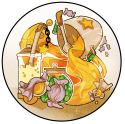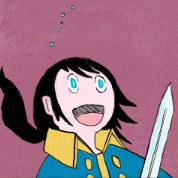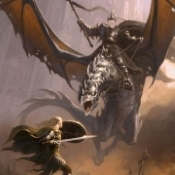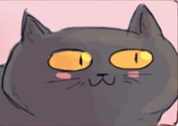|
I love the lizards, too. You have all that Ancient Aliens stuff but with magic blending in with this: https://www.kongregate.com/games/I_smell/robot-dinosaurs-that-shoot-beams-when-they-roar
|
|
|
|

|
| # ? Apr 26, 2024 09:27 |
|
Lizardmen were already super fun in somehow being the most low-tech, most high-tech AND most magical faction in the game, and Seraphon do the smart think to amp that all up to 11. Skinks always struck me as basically Warhammer's counterpart of D&D kobolds taken in a much more interesting direction of being basically the people of the civilisation who can actually function outside of war and being magical and mysterious. They have to be smart and flexible, and it shows. Also, they're adorable.
|
|
|
|
Dark Sun characters start at level 3 so they can better face the challenges of The Deck of Encounters Set Two Part 61: The Deck of Nabassu, Bar-Lgura, and Thri-Kreen 308: Fledgling The PCs pass by a farmstead where the cow is bellowing because it’s thirsty. The animals seem mostly okay, but there’s “no sign of intelligent life.” Fresh bloodstains on the floor and wall of the house, but someone tried to clean it up. It was a nabassu, which “left here yesterday to return to its lair.” But by wild coincidence, it’s flying back overhead and decides to eat the PCs, because alert, heavily-armed wanderers are just as good a target as unsuspecting homesteaders, right? (Nabassu have “High” intelligence, by the way.) Honestly, just skip the nabassu attack. Leave the house a murder scene and let the PCs deal with it or not as they would. They’re mid-level, so they could be able to follow up with some divinations if they want, but even if they don’t, it’s kind of cool to have bad things happen that they can’t deal with (yet). Keep 309: Baboon Fiends The PCs are in a jungle. There’s some descriptive text about how they’re enjoying the life around them, and then four bar-lgura attack (they’ve made it to the prime material somehow), starting out invisible and using illusions of “savage headhunters.” Then they entangle and attack, fleeing if two are slain. So “monsters attack,” then. No real specific detail besides the racist illusions. Pass. 310: Tik-Tik-Tik Dark Sun encounter. On on the Great Salt Flats, the PCs run into a thri-kreen with odd purple chitin who is slowly dying of thirst. (It takes a while for this to happen to kreen, but it does eventually.) If they give her water she’ll swear a life debt to one of them. Unfortunately, she’s never been in a city (or a trading tribe, apparently), doesn’t understand private ownership, and will definitely get them into trouble. She also doesn’t understand sleep and will wake up her human several times each night to make sure they’re not dead. Cute, I guess? It doesn’t make a whole lot of sense that Tik-Tik-Tik speaks Common but hasn’t even been introduced to these cultural concepts, though. And once she gets used to these things, her only personality hook disappears. But keep since Dark Sun characters in particular can often benefit from a few hangers-on. You know... if I was making a deck of random encounters with these cards for my Dark Sun campaign. Which I absolutely am not. 311: Bug Hunters The PCs are coming out of a desert, but have wandered into a thri-kreen tribe’s territory. A hunting pack surrounds them and one comes out to parlay, telling them to move on or be considered food. They don’t speak Common or anything, though, so if the PCs don’t have communication magic, this negotiation will have to be done in body language. Probably pretty uneventful, but establishing a thri-kreen tribe’s presence on the world map is something, at least. Keep. 312: Old Man Oak In a deep forest, the PCs are approached by a treant named Old Man Oak, who is friendlier than that rear end in a top hat Old Man Willow. But he still starts by looming out of the trees, grabbing up a PC (ideally with an axe), and asking them if they’re an orc. “Let the PCs respond, but note that the treant can detect lie.” Because if they aren’t orcs (as seems likely), they might… pretend that they are? Anyway, he killed some orcs a while back and one of their backpacks fell partway down a 100 foot cliff and got caught. Inside it is a “foul” magic item (a wand of defloriation) that the treant wants destroyed so that it can never be used against the forest. Seems OK. I would replace “random evil orcs” with some other group to make it more interesting. A group of soldiers or explorers who were supposed to create an outpost here for an amoral government or trading empire, who were supposed to use the wand to clear trees from a defensible perimeter, or some such. Keep.
|
|
|
|
what rear end in a top hat decided the world needed a giant bug kender?
|
|
|
|
90s Cringe Rock posted:what rear end in a top hat decided the world needed a giant bug kender? The difference here is that there's no suggestion that the bug can't learn.
|
|
|
|
Age of Sigmar Lore Chat: Seraphon Frog Secrets  Other peoples often underestimate the Slann Starmasters - they're fat, come off as physically frail, have small and somewhat withered limbs, and look like giant frogs. However, they are the greatest wizards ever to exist, and when they join a battle, it is a sure sign that something important is going on. The other Seraphon could never even begin to question their slann masters, whose immortal existence has guided them since the time before time - not that they ever really have a reason to. The slann may have total command over the other Seraphon and may never die of old age, but their perception of time is stretched out beyond that of mortals. For a slann, even an aelf is an ephemeral creature, too short-lived to pay much heed to. Their thoughts are attuned to esoteric calculations and cosmic theorizing, and many spend decades or centuries appearing to do little but sleep and eat while their minds are occupied with great thoughts. The slann rarely give commands, because they are far too busy calculating possible futures. This was, of course, by purposeful design of the Old Ones. The slann were their greatest servants, designed to be amployed in massive-scale cosmic construction, and so they were given minds up to the task and magical skills beyond mortal dreams, allowing them to grasp the principles of Realmgate technology. Some human and aelf sages theorize that the slann may have been responsible for making some of the first proto-Realmgates in the World-That-Was, which may be part of why it was destroyed. Still, no one can deny that the slann despise Chaos. All of their commands are bent towards the destruction of the Eternal Enemy, and the benefits of obedience have been shown time and time again. Not that slann always agree - each is an individual person, with their own opinions on how the Great Plan is best pursued. Their differing beliefs are made stronger because none of them can actually recall the Old Ones with perfect clarity, though even they aren't totally sure why. They must rely on fragments of memory, visions revealed to them in their contemplations and the copies and remnants of ancient plaques that bore instructions long ago. It's not easy, and even the slann struggle with how to correctly interpret all these things together. They are aided in this by the skink Starseers and Starpriests, who serve as advisors and administrators for Seraphon society. In practice, the skinks are the ones actually running things on a day-to-day level, freeing their Starmaster to focus on the grand overview of existence, the flowing of the Astromatrix and the omens of the stars. In battle, most slann rely heavily on a team of saurus bodyguards to keep them safe from attack. They sit atop celestite palanquins that utilize Old Ones machinery to hover over the field, and most palanquins incorporeate weapons that can fire blasts of killing lightning. They may appear frail and torpid, but their total mental control over their palanquin's weaponry means they rarely have much to worry about, especially when combined with their magical aptitude and ability to influence and call on stellar alignments. The Starborne slann, in particular, tend to wield terrifying power, as they summon forth new soldiers from their ships. The physical form that Starborne Seraphon take when teleported down varies somewhat due to their strong connection to their slann, altering based on the emotions the Starmaster is feeling. Anger often produces blood-colored scales, for example, while a slann whose mind is straining or failing can result in warriors whose appearance is warped or grotesque. In all of existence, there have only ever been five spawnings of the slann. The Fifth Generation, the youngest of them, are already older than the Mortal Realms, however, and and no more will ever exist, as far as the Seraphon can tell. Each spawning was intended for a specific purpose in the Plan, and they each hope they aqre living up to the task. None of the First Generation live, and of the Second Generation, fewer than five remain. The slann know that each death among them is a permanent loss, one they cannot recover from. Thus, each slann tends to be very focused on their own survival - not from fear, but from a desire to be present when Chaos is at last defeated forever and the Great Plan can be made real. Slann are very hard to kill, but not impossible. Those who fall are given the utmost respect by all Seraphon, their forms treated with even more reverence and worship than they were in life. The body is collected and taken back to its constellation's temples for mummification. The fallen are known as Relic Priests, and their bodies are still awash with magical power. There is no afterlife for a slann - their mind and soul remains within their broken body. It's unclear exactly how much control they retain over their magic or how much they can affect the physical world, but some Seraphon forces, especially among the Coalesced, are known to carry Relic Priests into battle. Their golden funereal masks glow from within, and powerful spells still emanate from their forms, attacking the foe. Even in death, the slann are utterly dedicated to service of the Great Plan and war on the Eternal Enemy.  There is no Relic Priest older, more mysterious or more potent than Lord Kroak. Magical energies flow endlessly from his withered body, and his simple presence is enough to destroy weak ghosts and daemons. It is believed by the Seraphon that Lord Kroak is the eldest slann, the first to exist, and perhaps may have been alive and accompanying the Old Ones when they first arrived in ancient times, rather than being spawned after. It is known that Kroak has sacrificed his body many times in the fight against Chaos, and that he always returns. He has not been alive since well before the history of the Mortal Realms; this doesn't matter. He is part of no constellation, appearing wherever he is most needed, when fate hangs in the balance. His merest thought can tear a comet from the sky and hurl it across a realm, can call forth Starborne warriors from any vessel, can unleash a storm of Azyrite lightning. When the battle ends, he vanishes in a shimmer of starlight. The skinks say that he has ascended to sit at the right hand of the Old Ones in death, that he has chosen to never rest in death so long as Chaos still exists. Next time: Spawn-Lords of the Saurus
|
|
|
|
Lord Kroak is how you do a corpse-god-emperor on a golden throne right.
|
|
|
|
So Lord Kroak is the Legion of the Damned now? I'm cool with this, the Legion of the Damned was always one of the rare 40K thing I just plain can't fault in concept, and the Legion of the Damned being a mummified frog from the dawn of time only improves them.
|
|
|
|
MOTHERSHIP PLAYER’S SURVIVAL GUIDE - Part 10: Wrapup OVERALL THOUGHTS Mothership is only 40 pages long. The book itself would take less time to read than this review of it. It packs a lot into those 40 pages, but what it packs in isn’t always good. There’s a notable focus on style over substance, a lack of attention to important detail, and a pervasive feeling that the numeric elements of the rules were never playtested. THE GOOD
Mothership is like Earthworm Jim, The Neverhood, or any other Doug Tennapel video game. It oozes charm and is widely beloved by the internet, but the gameplay isn’t actually very good at all. It did not surprise me when I learned that the lead developer on Mothership, Sean McCoy, was a graphic designer first and a game designer second. Mothership has an important lesson to teach us: just because mechanics are simple does not mean they’ll be fast and fun to use at the table. It also exposes a critical weakness of today’s crop of OSR games. Minimalism can make a game easy to learn and teach, but can also make it hard to run and play, by omitting important context. By assuming the reader is already familiar with a vast array of blog posts and manifestos on the proper way to run and enjoy them, games like Mothership can actually be more alienating to new users than games with complex, dense rules. In a previous review, I poo poo on Esoteric Enterprises for being an “incomplete” mess, and looking back, I don’t think that was fair. It was clumsy and hacked together, but it put in a lot of work to teach the DM and players the best way to enjoy the game. It had instructions about what everyone was supposed to do, and how to do it. It had detailed world creation rules, and a system for bringing that world to life. It was a self contained package that didn’t depend on the reader being intimately familiar with a decade of internet arguments about the true nature of RPGs. Mothership is still in development. There’s eventually going to be a GM facing book, along with rules errata to fix some of the issues with the base game. I do sincerely hope that this book fixes the problems with the Player’s Survival Guide. Until it comes out, I would not recommend running or playing Mothership. Some of the published modules are good, but are also easy to port to a more competently designed game. Thanks for reading, FATAL and Friends. No idea what I'll read next. Maybe Maria in Three Parts, or something for Delta Green.
|
|
|
|
Lord Kroak is rad. I am all for this semi immortal undead frog appearing in my time of great need. Coolest guardian angel.
|
|
|
|
Mors Rattus posted:
KittyEmpress posted:Lord Kroak is rad. I am all for this semi immortal undead frog appearing in my time of great need.
|
|
|
|
Arkham Horror the Living Card Game 8 - Follow-Up, Roundup, and Closing Thoughts Previously on The Gathering, Harvey Walters and Nathaniel Cho successfully escaped from the study, broke the barrier, and defeated the Ghoul Priest successfully completing the scenario. At the end of it crazy lady Lita Chantler demanded that Harvey burn down his house. I put his response to vote in the thread and surveys says… https://www.youtube.com/watch?v=en1uwIzI3SE So there we go. As a result we read resolution one in the campaign guide:   Pay attention to that bit about marking things in the campaign log, because that's the way the game does it's longer term story stuff. Your actions do indeed change the campaign going forward in small or larger ways. The most obvious? In the next scenario if your house is still standing it's a place you can actually go to. If not, it isn't. Also the Ghoul Priest. If he is still kicking around then he goes in the encounter deck and is a very real chance you will have to deal with him in a later scenario. He's not mentioned here because the only way to get this ending is to cave in his skull, but if you fled in The Gathering he's still around to make trouble. And speaking of the next scenario it's called "The Midnight Masks", and I will not be giving a blow-by-blow play through of it. I'm still going to talk about it for a little bit.   The Midnight Masks is one of a number of scenarios in Arkham Horror where complete victory is unlikely but some degree of success is nearly certain. As the act informs you there are 6 cultists around Arkham and your job is to go look for them gathering clues from Arkham's various locales and basically acting like the 1920s Cthulhu version of that one Batman panel. And what a setting it is! Unlike being stuck in a couple of rooms of your house the field for The Midnight Masks is the entire town of Arkham. Turn length in Arkham Horror and the length of actions is rather abstracted and here you have going from district to district happening in a single action over the course of a scenario that in universe only lasts an afternoon into the evening. Every location Arkham has its own ability, most positive with one or two negative, so you're encouraged to run around town making the most of your time to collar as many cultists as you can. During set up along with either putting your house in the play (or not) and seeding the Ghoul Priest into the encounter deck the game instructs you to set aside the five unique cultist enemies into a separate cultist deck. Each one of the cultists is a victory point enemy but the majority of them have a unique method for instantly defeating them.  Victoria Devereux here can simply be bought off if you have the resources, defeating her, getting information out of her, and probably getting her out of your hair for future events. Or you can beat her to death, that also works. Each of the cultists appears in a different location and depending on your group's make up and your various skills will determine whether it's wiser to fight with them or negotiate with them. And as the Act itself points out the sixth cultist isn't in the cultist deck. The last cultist is hidden in a really amazing bit of gameplay that's only possible in something like a card game, and it is such a work of genius that I don't want to spoil the surprise. I suggest you play the game yourself to learn where The Masked Hunter is hiding. One last point of interest about The Midnight Masks is that the locations you go to around Arkham are randomized to an extent every game. The graveyard, Miskatonic University, St. Mary's Hospital, Rivertown, and a couple of other neighborhoods are set in stone but there are two versions of the Downtown and Southside of Arkham each with their own effects set up and play randomly. This is fairly common in scenarios going forward as a way to give some degree of replay value, as the board may not be exactly the same the next time you try it. Also important! The Midnight Masks brings in the Dark Cult encounter set, and all the nailbiting fun that one brings.  Dark Cult is the encounter set all about Doom. None of the enemies in it are actually that tough but they all come with or generate Doom, and the one treachery card in the set piles even more doom on already present cultists. When Dark Cult is in play you need to be very vigilant at winnowing down the cultists to give yourself enough time to even investigate. Chances are good you'll get some before you're out of time and have to resign, hell you'll probably even bag most of the cultists running around, but you're really unlikely to get all of them. But don't worry! They're still going to show up in the final scenario of Night of the Zealot, The Devourer Below. In The Devourer Below you'll discover that the cult and the ghouls all worship a game original Great Old One named Umordhoth. Thus, it is your job to run out in the woods and try and prevent the summoning of an Ancient One right on Arkham.   Keyword on "try". See, while The Gathering is a straightforward enough tutorial game that teaches you about moving, investigating, and dealing with monsters, and The Midnight Masks introduces you to Arkham scenarios where success can be partial and you can cut your losses and where the field is mostly yours to do with as you like, The Devourer Below is notorious as a complete meatgrinder of a scenario. If you're running with just cards out of the core box you will almost certainly die horribly. The scenario is beatable, yes, even with just core box stuff, but it is still notorious for its brutality and widely considered one of the worst scenarios for that very reason. This is where players go to die, and it actually probably works a little better if you look at it as the Arkham Horror version of the Kobayashi Maru. The Devourer Below has a mix of many of the nastiest bits about the previous two scenarios. You've got the ghouls again along with Dark Cult along with a lot of really mean locations and and cameo appearances by the encounter sets for agents of Call of Cthulhu's big four. Thus you either get Agents of Cthulhu with deep ones and previously posted Dreams of R'lyeh, Agents of Hastur which is just generally bad for your sanity, Agents of Yog-Sothoth which includes a Yithian jerk and a particularly cruel spell, and Agents of Shub-niggurath which is comprised entirely of tough monsters including a Dark Young. Basically, the odds are REALLY against you. Also Umordhoth himself has an absolute beating of a treachery card just to prove he doesn't need celebrity guests to kick you around.  Note that you can't discard cards from your hand if you don't have any Continuing with continuity, though, the more cultists that escaped from The Midnight Masks the more initial Doom is put on the agenda and the more of them you will have to deal with when you finally reach the summoning circle. Also, if you STILL haven't ganked the Ghoul Priest he's in the encounter deck again so have fun with that. And yes, if you run out of time you do have to fight Umordhoth. The odds? Let's say they're not really in your favor, though it isn't impossible either.  Note: Ancient Ones don't have the "monster" trait so Lita's ability won't help you here So! You've dealt with Umordhoth (or thrown Lita to the wolves), what next? Well like I said previously Arkham horror currently has 6.5 campaigns including Night of the Zealot so there're plenty of scenarios and campaigns to go through.  The Dunwich Legacy (associated ancient one: Yog-Sothoth) as the name implies is a direct sequel to The Dunwich Horror. Professor Armitage has got a bad feeling about this and sends the PCs out to grab professors Morgan and Rice so they can get the gang back together and try to stop a repeat of the Whately incident. Over the course the eight scenarios you'll try and figure out where Morgan and Rice are, recover the Necronomicon, have a harrowing train ride over to the town of ill repute, and try and put a stop to the bad mojo going on. The Dunwich Legacy encounter sets include horrible hybrid thrall monsters, extremely ordinary criminals and gangsters, Whippoorwills, hideous abominations, and lots and lots of wizardry. A recurring nasty card suite is the "Sorcery" set with its signature card Beyond the Veil slamming you for milling out.  Surge means "Draw another encounter card after this one" by the way Ordinarily when you mill out in Arkham you take a direct horror to your character and then reshuffle your discard. Beyond the Veil plus a number of cards means that deck destruction might just be your destruction. Also I want to call out the Whippoorwills are especially obnoxious jerks in this campaign.  "Aloof" means that the birds won't automatically engage or attack you, but it also means you need to intentionally spend an action engaging them before you can attack them, and Hunter means they'll follow you around passing out stat penalties. You're absolutely within your rights to call in a hit on those birds.  Not joking in the slightest Notable scenarios in The Dunwich Legacy include a race through The Miskatonic Museum where the encounter deck has only one monster, but it gets bigger and bigger and bigger the longer you spend in the museum, The Essex County Express which is a harrowing race against time as you try and get the titular train running before you're pulled into a dimensional rift, and Undimensioned and Unseen where it turns out Armitage's final battle against The Dunwich Horror made it look easy. And speaking of Armitage the main continuity mechanic of The Dunwich Legacy involves rescuing sacrifices intended for Yog-Sothoth. Morgan and Rice might be on this list, as might Armitage himself depending on your performance along with minor Novella characters Earl Sawyer and Zebulon Whately. And if you're really unlucky, you might lose allies out of your deck so move fast!  The clock is ticking...  The Path to Carcosa (Associated Ancient One: Hastur naturally)is a mindbending and deliberately disorienting campaign of unreliable narration and madness.The PCs gather together for an incredibly ill advised trip to the theater to watch The King in Yellow and fall asleep at the end of the first act only to wake up in a theater full of corpses and monsters. As you try and get your bearings and figure out what's going on and how to get out you find The Man in the Pallid Mask, the unnamed person who played the role of The Stranger in the play. And so begins the chase.  Following up on the play you go to the after party and find it riven with madness, violence, and corruption. From there on the cast go from lead to lead trying to track down the people behind production of the play, it's true meaning, and ultimately must cross the ocean and follow the path to Carcosa in order to close the way and keep Hastur locked in his prison in the realm of madness. The Path to Carcosa, appropriately considering which Ancient One is in play for this one, is heavily predicated on a madness, horror, and corruption. Expect varying flavors of psychopaths, muck, corruption, and cockroaches, hidden cards that inflict debilitating insanity, and in dire circumstances fights with denizens of Carcosa. Of special note are the various bad omens representing Hastur's growing influence.  The Path To Carcosa has two major continuity mechanics. The first is chasing the stranger. The Man in the Pallid Mask dogs your every step acting as an additional weakness enemy. He is not particularly dangerous even with his own special encounter set, and the game encourages you to defeat him as many times you can. Perhaps that will help you get to the bottom of this. The second continuity track are the paired measurements of "Doubt" and "Conviction". How much of this is real? Can you trust your own perceptions when you face The Tattered King? If you believe that there surely must be a reasonable, maybe even rational explanation then you Doubt. On the other hand if you believe that there is a god named Hastur and that he must be stopped then you have Conviction. The form of many of the scenarios in The Path to Carcosa vary radically depending on whether you have more Doubt or Conviction. In one version of the scenario you must chase down a fleeing figure, and the other version of the scenario roles are reversed and the figure is an implacable and immortal enemy you must flee from until the agenda expires. Most scenarios in The Path to Carcosa are great, but some standout scenarios include The Last King are you infiltrate the aforementioned mad dinner party trying to find as much information as you can about the play The King in Yellow as the full reality of what you're seeing sinks in and your true danger appears. Another is The Unspeakable Oath where you need to infiltrate Arkham Asylum and find a lunatic from its depths who may be able to tell you what you need to know about Hastur. Finally there is Black Stars Rise, a scenario with two agenda decks and no act deck, the path is here somewhere, can you find it before it is too late? The King in Yellow intends on making the earth his, can you stop him? Or have you already stopped him? Or have you already failed to stop him? Doesn't this all seem somehow familiar?  Has this happened before?  The Forgotten Age (Associated with Yig) is perhaps the least loved campaign in Arkham Horror which is a pity because it has a killer hook. Your group of PCs is joining an expedition into the Mexican rain forest in hopes of finding a central American city state that has to date gone completely unnoticed by the rest of the world. It has the potential to be the find of the century if you can find it out here in the untamed wilds. Of course you do find it, but that's only the beginning of your problems. The big new thing in The Forgotten Age is the exploration deck. Often when the scenario begins in TFA you have only one starting location and have to venture out into danger in order to find more.The danger here is that the exploration deck is also seeded with encounter cards, and if you pull one you must immediately resolve it. Thus you need to balance the need to press further and uncover specific locations or more clues with the threats lurking in the exploration deck. And even if you don't run encounter card, some locations are inherently dangerous. For instance, you might find a snakepit appropriately full of snakes that you don't want to deal with. When you explore successfully you automatically moved to the new location whether you like it or not. It almost makes you wish you had some binoculars doesn't it?  That line about binoculars represents The Forgotten Age's first continuity mechanic: supplies. At certain points in the campaign you're given resource points with which to buy from a list of supplies which include everything from a Map or Compass to standard adventuring tools like Rope to survival gear like Rations or a Canteen. Certain locations and enemies in certain situations both in gameplay and between scenarios will reward/punish you for having/not having certain supplies. For instance, in many scenarios having a certain supply will allow you to scout ahead in the exploration deck to purge yourself of treachery cards or guarantee a successful outing. The supply system is both a positive and a negative because The Forgotten Age is notorious for opening with a bunch of forced trauma to all players who haven't bought certain supplies at the start of the scenario. While some interactions are generally cool and make you feel good for planning ahead just know that the good comes with the bad. The second continuity mechanic is Vengeance. The serpent God Yig may not be actively malign, but he is vengeful and taking the lives of his worshipers and his favored invites his wrath. Along with Victory enemies in The Forgotten Age may also be marked with Vengeance as a keyword. Enemies thus killed award you with points of vengeance that is tracked from scenario to scenario. It's nearly impossible to completely avoid Vengeance, but accumulating too much of it may force you down unpleasant narrative paths and moreover Vengeance earned in the scenario may make things harder for you.  Serpent from Yoth is not a joke even before his special abilities start to stack up And of course since our enemy is Yig, the father of serpents there's always the danger of venom. You really don't want to be poisoned, so it is unfortunate that the game has many ways to give it to you.  On its own poison doesn't do anything but there are many cards and enemies and chaos tokens that make being poisoned painful. You can buy an antidote with supply points, but such a cure is a one time thing and you can readily be poisoned once again should you be careless or unlucky. Still, it is about the only way to cure that condition.  Pick your poison... Speaking of continuity, where does The Forgotten Age take you? Well after completing the first two scenarios of The Forgotten Age you've more or less completed the first 10 minutes of Raiders the Lost Ark except this time you actually got out with the ancient artifact:  and when you go back to Arkham your first thought is to try and figure out what it is. Unfortunately, shortly thereafter one of the guardians of the ruins arrives and informs you that removing the relic has somehow broken time and now it's up to you to fix history before existence itself unravels.To do so you must return to the Mexican rain forest and descend through the ruins into Yoth, the innermost depths of the earth until you reach the Nexus of N'Kai where time can be put right. What complicates matters are the great race of Yith who created the relic for… some reason. As you progress you may align with the serpent people or with the Yithians, or with neither of them. All of time is now your responsibility, choose your friends wisely. The Forgotten Age is notorious for having two of the arguably worst scenarios in Arkham Horror back to back (Boundary Beyond and Heart of the Elders), but it also has a couple of really good ones. The Threads of Fate sees you running around Arkham with three tasks: an enemy to hunt, a friend to rescue, and the relic to recover. Can you do all of them in time? The City of Archives is another fascinating scenario because you do not play as yourself, rather you've been displaced into the body of a Yithian and must find a way to return your mind to where it belongs. Finally The Depths of Yoth sees you descending ever downward. Yig and his children are at your heels, can you reach the bottom of the world before they reach you? The Forgotten Age is also notorious for being a step up in difficulty from the previous campaigns. The next campaign is often seen as equal in difficulty, though it gets a little bit easier as you progress.  The Circle Undone (Associated with Azathoth) is a campaign about Arkham. The previous major campaigns had you leave Arkham to travel to locations near and far, but The Circle Undone stays in Arkham right up until the end. The titular town of Arkham Horror has enough mysteries, histories, and tragedies enough for an entire campaign as The Circle Undone demonstrates. It begins not with your characters and investigators but rather with four civilians. When The Fraternal Order of the Silver Twilight, better known as The Silver Twilight Lodge, threw a party at the manor of one of their well-to-do members four denizens of the party simply vanished without a trace. Their story opens The Circle Undone and you the players play them in possibly their last moments, drawn the spectral realm hemmed in by mists and chased by The Spectral Watcher, an immortal being as implacable as death.  Where your characters enter play is when they are caught, and separated in the woods of Arkham. A coven of witches is preparing a spell to do… Something, and caught in the middle your characters must find a way to reunite and break the spell in order to escape from the woods. Of course this is only the beginning, when your reunited characters returned to the scene of the vanishing they end up in the same situation and must find a way to escape the mists. From there you'll travel across Arkham's many infamous landmarks digging into the past to try and understand the forces that are arrayed against you. The Circle Undone has two continuity tracks. One is the hunt for the four missing victims, are they still alive? Are they dead? Or is their fate even worse? The second are the mementos you acquire as you travel Arkham searching for clues. These mementos may be something as solid as a journal or ritual components or something as esoteric as a scrap of torn shadow. Whatever they are, whatever they're for, they may just be able to save you in the end. The deeper continuity element comes with the factions that are vying for mystical dominance in Arkham. On one side is Carl Sanford's Silver Twilight Lodge, a respected order with many layers and many secrets. You may join them, or you may become their enemy. They speak of the greater good but can they really be trusted with the power they pursue? Can anyone? On the other side is the coven of the witch Anette Mason. You may have gone on their bad side by disrupting the ritual in the woods but it was purely by happenstance. Can you possibly make amends? Should you make amends? The fate of Arkham and maybe the world is in the balance. Choose your fate wisely… A recurring theme in the encounter sets of The Circle Undone are cards that stay in play to your detriment. Where witches go so goes witchcraft and the many curses and hexes you may accumulate may hold you back, though if you can "convince" a witch to help you you might be able to escape the curse. Otherwise you'll have to break the spell yourself.  I genuinely love the flavor of this card Another dangerous encounter set is Inexorable Fate. The future seems to hold nothing but grim tidings in The Circle Undone, can you fight fate?   If you intend to play The Circle Undone look for the handful of cards with the ability to discard treachery cards and play. And make sure you bring enough ways to boost your Willpower, even by the standards of Arkham Horror, The Circle Undone puts a premium on that stat.  A new keyword is also in play in The Circle Undone, "haunted". If you fail to investigate a haunted location then its haunted trigger activates doing whatever bad things that location will do to you. And be careful, there are enemy and treachery cards that also will trigger haunted effects if you're unwary or unlucky.    The Circle Undone will send you to all corners of Arkham. The Secret Name has you travel into The Witch House, a currently unused former boarding home of ill repute. Though long abandoned by humans, the witch's familiar Brown Jenkins still lurks here as does the spirit of Nahab who signed The Black Book. Can you make it through and beyond The Witch House and disrupt the evil lurking there? Meanwhile in The Wages of Sin will be forced to account for Arkham's evil history as you attempt to lay to rest heretics who were hung at the gallows. Finally, as the endgame approaches will have to run around Arkham in triage mode playing your own little game of Pandemic for In the Clutches of Chaos. The end is near, for Arkham, for the universe, and for this post because there's only one more major campaign left.  The Dream Eaters as I've mentioned before is split into two 4-part campaigns. One taking place in the Dreamlands, the other taking place in the waking world. The campaign taking place in the Dreamlands is The Dream Quest, the one of the waking world is The Web of Dreams. In The Dream Quest (Ancient one: Nyarlathotep) your characters follow the journey into dreams outlined by weird author Virgil Gray (and of course the stuff laid out by Lovecraft in "The Dream Quest of Unknown Kadath"). You will descend The Seventy Steps of Light Slumber, pass into The Cavern of Flames, descend further down The Seven Hundred Steps of Deeper Slumber, and then finally reach The Enchanted Woods wherein live The Zoogs. There you will meet both Virgil himself and the veteran dreamer Randolph Carter and begin searching for Kadath, the city of the gods. In The Web of Dreams (Ancient one: Atlacha-Nacha) you follow the characters who stayed in the waking world as Arkham is beset by curious epidemic where people go to sleep and and don't wake up. What started as curiosity when half of your group attempted to follow in Virgil Gray's footsteps has now turned to alarm when you're sleeping companions are taken to St. Mary's Hospital along with many others to seem to become their dreams. Worse yet, at the hospital you discover that a new kind of strange infestation has come as the building becomes infested with spiders and spiderlike monsters. Seeking to quell the infection and find answers you team up with a resident of the hospital, one Randolph Carter, who knows many things about the Dreamlands. At his counsel you seek a way to physically enter the Dreamlands and discover what has gone wrong. Each campaign has its own continuity mechanic. The Dream Quest has you searching for signs of the gods, knowledge and markers that may direct you towards Unknown Kadath. Meanwhile in The Web of Dreams you must pay attention to Steps of the Bridge, which indicates the progress of some great and malign work. That path is one that must not be opened. And of course there is a black cat. While you can play The Dream Quest and Web of Dreams individually you can also combine them into an eight-part campaign where each player has two decks (or maybe two groups of players each play one of the smaller campaigns) and there are mechanics in place to reward you for the grander choice.  That's some subtitle... As you complete scenarios on both sides in the grand campaign you'll encounter The Black Cat. The cat knows many things and has a hunch or two about what's actually going on. He is your go-between linking the dream side and the waking side and can bring tidings from one group to the other. With care and cleverness you may just be able to unravel the web and save both worlds. Encounter sets in The Dream Eaters vary widely between the Dreamlands and the waking world. Those in the Dreamlands have to worry about its denizens like the Zoogs, and the corsairs of Leng. They need also worry about the machinations of Nyarlathotep and the irrational laws he inflicts on you. There's also phenomena related to the Dreamlands, as much as its place of wonder it's also a place of danger.   In the waking world investigators deal with threats like the merging of reality and the many spider children of Atlacha-Nacha. They may not need to worry about Zoogs, but there are plenty of terrestrial dangers and what's worse all the creatures that have crossed over from the underworld of the Dreamlands. No, not Zoogs, but Ghasts and Gugs stand in your way.   Standout scenarios in The Dream Eaters are many, but of special note are The Search for Kadath in The Dream Quest and A Thousand Shapes of Horror in The Web of Dreams. The Search for Kadath has you traveling the Dreamlands's every direction seeking knowledge and history that might point you the way to the city of the gods. You will go to Ulthar where no man may kill a cat, you will reach Ib and Sarnath and learn of the DOOM that came, and the Timeless Realm of Celephais ruled by King Kuranes. Meanwhile in The Web of Dreams you will travel to The Unnameable in A Thousand Shapes of Horror seeking a way to bodily enter into the Dreamlands. In the unnameable house you will encounter the titular Unnameable thing, the ultimate abomination. With an indescribable creature on your heels can you find another pathway down? There's one more Arkham Horror campaign to come starting in October, The Innsmouth Conspiracy, which promises to take your characters to that curious town where the people wear gold and are quite hard to drown with its own mechanics where you must recover how and why you came to this godforsaken place before you're sunk, either by deep ones or by the swiftly flooding town. Where that one goes who can say yet? And with that, I think I'm just about done with my F&F for Arkham Horror the Living Card Game. There are probably a couple rules I missed here and there and there are a couple more products I can talk about (return to… boxes which revamp and shake up existing campaigns and standalone scenarios like one where you have to solve a murder mystery or another where you have to protect the people of Venice during Carnevale), but I think I've given as good an overview as I've wanted to for this game. As is probably transparently obvious I love this game a lot. It is my favorite Cthulhu game and one of my favorite card games period. I like the way that it can tell a story and also be an effective granular gameplay focused cooperative card game at the same time. I love the way that the game can use mechanics and special set up instructions to invoke a lot of different feels in a lot of different styles within the bounds of said game. I like the way that it has modular difficulty that you can tweak up and down, and I appreciate that it has a lot of different ways to engage with it. As of now there are over 40 characters to play as each with their own style and gimmick, any of which are viable and interesting and useful in your group. Arkham Horror is my favorite kind of Cthulhu. It can be tense and scary, a battle against seemingly impossible odds, but also a battle you can win. You can beat the Mythos, you can injure and thwart any God less than literally Azathoth. You can banish Nyarlathotep from the Dreamlands, you can thwart the designs of Hastur, you can go toe to toe with Yig. You can win, and I think that's important. Even in cosmic horror being able to win at least in the moment is worth something. Even if your investigator's too short life is fated to end and eventually become forgotten, dust in the wind, that still doesn't change the fact that you made a change. The God may not be dead because even Death May Die and the God may try again, but in that moment you did the impossible and you won. Someday, The Stars Will Be Right, but it wasn't today. Today that God learned that fire is indeed hot when you turned your flamethrower on them and held down the trigger.  And any game where you can do that is kind of special in my book. Omnicrom fucked around with this message at 00:03 on Apr 13, 2021 |
|
|
|
My own review will be a bit delayed while I go through a side project to run my normal WHFRP group through one or more of the adventures from the book, to get a better, more recent feel for them before I review them. But yes, I think the feeling of being able to do something, even if the something is small, or incomplete, or the horror yet lurks in the grand scale of geological time is important in an interactive medium, especially. 'All was futile and nothing mattered' is easier to deal with in a book or movie than something that you're playing, potentially over several weeks or months or years, and feeling more directly responsible for.
|
|
|
|
Age of Sigmar Lore Chat: Seraphon SAVAGE DRAGON The Saurus Spawn-Lords are saurus veterans, warriors that have lasted many battles and become skilled in both personal warfare and leadership. They develop an instinct for strategy that surpasses words - many would be unable to explain the nature of, say, defeat in detail or defense in depth, but they intuitively sense when these methods should be used and how. They know the commands to bark or growl to their fellows, giving simple orders that produce complex results even when their subordinates lack their understanding. They are all heavily muscled, and as they grow older, their scales harden and become tough as stone while their muscles grow thicker and more potent. Their bodies become scarred and battle-weathered, but age brings no weakness to a saurus. Instead, they develop an aura of primal power that speaks into the minds of animals and other Seraphon, leading them to treat the elder saurus with deference and respect without even thinking about it. Even the slann are somewhat hesitant to gainsay the Spawn-Lords on matters of war. Under the Spawn-Lords are the Scar-Veterans, the frontline commanders. Each Scar-Veteran commands a small group of saurus, given command due to their demonstrated ability to rouse the saurian fury that urks in the hearts of every saurus. That is the most prized leadership ability among the saurus - the ability to hold back and unleash the rage within their fellows. Those Scar-Veterans that survive many battles are raised to the rank of Oldblood. The Oldbloods are the generals of the Seraphon, often entrusted with powerful sacred relics and weapons of the Old Ones, such as laser gauntlets or spears that burn with solar flame. It is commonly believed by many non-Seraphon that saurus don't talk; this isn't true. A saurus can speak, and particularly Scar-Veterans and Oldbloods can communicate effectively with others. They're just not very talkative, and younger saurus have often not developed their vocabular beyond monosyllabic words. Commanders learn words more out of necessity than desire, and still tend to be eloquent only on matters of war or strength. Internally, the saurus subculture is very focused on development of physical strength, hunting skill and strategic mastery. Disagreements between saurus leaders are settled via ritual combat, as the saurus are instinctively driven to respect deeds over words as authoritative. The greatest of them wield that strength to tame the powerful Carnosaurs, the most ferocious and dangerous of the warbeasts the Seraphon breed. A Carnosaur at full growth is over thirty feet from nose to tail, and they aren't your weak-armed tyrannosaurs of older dinosaur pictures. A Carnosaur's forelimbs are exceptionally powerful, used to pin prey down so their immense jaws can be brought to bear. The roar of a Carnousaur is enough to win battles on its own, as most mortals won't remain around long enough to fight the dang thing. When they do fight, Carnosaurs enter a brutal frenzy of blood and carnage, kept from going mad only by the will of their saurus lord. Sunbloods are a rare breed of saurus, charged with the magical power of Azyr's stars. All Sunbloods are exceptionally strong, even more than most saurus, and they are raised to be the champions of the Seraphon. In battle, they never pause or rest, moving as individual warriors among the massed ranks of their brethren as long as they can find any enemy to hunt. They are armed with powerful aeon shields to blunt attacks, absorbing their impact and leaving the enemy open for their vicious jaws and heavy celestite maces. Sunbloods are rarely strategists, leaving that to the veteran Oldbloods, but have an innate sense for weakness in their foes. They make their way to critical points in battle, roaring out mighty challenges to encourage the saurus around them to greater heights. For other Seraphon, the Sunbloods are awe-inspiring figures. Their scales shine blue and white with Azyrite energies even among the Coalesced, and they are chosen to stand as the guardians of key areas in Seraphon temple-cities and temple-ships when they aren't on the hunt. Sunbloods do not spawn particularly often - most of those alive today were born in the Age of Myth, and new spawnings occur only on the eve of key celestial alignments. Some factions of skink priests believe that each Sunblood contains within them a wellspring of celestial magic, marking them as star-chosen even when they become fully physical. The saurus rarely think that hard about it - they see the Sunbloods as demigods, avatars of an ancient war-god or reptilian superpower, returned to life to fight alongside them. Coalesced saurus especially are prone to hero worship of the Sunbloods in a practically literal sense, as they remain a tangible link to the stars of Azyr. Some saurus are chosen to be Astrolith Bearers. An astrolith is a large disc of carved celestite, marked with magical glyphs. At its center is a globe made from some bizarre material known only to the Seraphon. They are one of the stranger Old Ones devices that is in common use among Seraphon forces, and outsiders find them very baffling. In ancient ruins or forgotten caves, the Seraphon sometimes discover recesses that are perfectly fit to an astrolith's shape. Filling these holes with an astrolith has allowed several Seraphon expeditions to uncover lost caches of Old Ones knowledge, as the icons channel massive amounts of celestial energies and typically unlock hidden chambers or open lost Realmgates. Further, the icons channel magic that can empower the Seraphon around the bearer. Astrolith Bearers are rarely the best fighters in their constellation, nor their best leaders. They are chosen because the slann have declared them to possess a destiny of greatness. Saurus are not typically known for pride, but to be chosen as an Astrolith Bearer is an honor even they recognize. Any bearer would die many times over before letting their astrolith fall, and they are more than happy to kill any enemy that gets close even as they hold the icon to the sky. Astroliths are most common amonst the Starborne, as their presence accelerates the transition used to summon warriors down from the temple-ships. The more astroliths are around, the easier it is for the slann to summon large groups, causing the icons to glow with a burning white heat. The most sacred duty that can be granted to a saurus, however, is that of Eternity Warden. An Eternity Warden has one job: keep a slann alive. The Seraphon are well aware that their enemies are quick to target their fat, slow masters, after all. The Eternity Wardens exist to make sure that saurus leaders can focus on strategy without having to dedicate half their time to making sure the slann is safe, because they are trusted to handle any danger. The Eternity Wardens wield massive power in Seraphon society, because a slann's Warden is the one who decides whether or not anyone gets to talk to the slann. If the Warden says no, you'ren ot getting in, period. This applies to other Seraphon, too - if a skink can't convince the Warden of the importance of what they need to talk about, they wouldn't have any chance of convincing the slann, after all. In battle, an Eternity Warden is always in one of two states: total stillness and brutal murder. When their charge is safe, they don't move. They position themselves to keep watch over the enemy and wait. Those that come too close, however, are torn apart by powerful blows from their celestite maces, each one struck with the minimum necessary motion. An Eternity Warden never overcommits to a blow, because they always have to be ready to shift into defense. Their very presence drives the saurus around them to fight harder, for to impress an Eternity Warden means to earn the approval of one intimately trusted by a slann, and to be judged a coward is a fate worse than death. The Eternity Wardens know that most of all, and they never hesitate to sacrifice themselves for their masters, if it comes to that. There are many Seraphon legends about the heroic self-sacrifice of the Eternity Wardens. Strangely, a slann's new Eternity Wardens often grow very, very similar to their old ones, down to their fighting style and where they develop battle scars. Some skinks believe this is because the saurus chosen to become Eternity Wardens aren't actually living beings, but instead made from pure celestial energies, reborn over and over until the Great Plan is completed and their slann can finally rest.  Next time: Saurus day to day life
|
|
|
To those who are pure of heart, all that is necessary to join the Kroak Gang is the awareness that Kroak exists.Night10194 posted:But yes, I think the feeling of being able to do something, even if the something is small, or incomplete, or the horror yet lurks in the grand scale of geological time is important in an interactive medium, especially. 'All was futile and nothing mattered' is easier to deal with in a book or movie than something that you're playing, potentially over several weeks or months or years, and feeling more directly responsible for.
|
|
|
|
|
Night10194 posted:My own review will be a bit delayed while I go through a side project to run my normal WHFRP group through one or more of the adventures from the book, to get a better, more recent feel for them before I review them. Absolutely. That sense of achievement is vital; you can play a game without it, yeah, but it isn’t likely to as memorable. It holds on a small scale. In, say, Changeling: the Lost, your goal is usually to survive despite being terrified and traumatized. You probably won’t be changing the world, but the sense of achievement you get from making a difference in your personal life can be just as rewarding. In some other games (like Fiasco), you can even get a sense of achievement from building a wild story, even if nothing changes afterwards. But the whole fetishized “nothing matters” you get from nerd CoC is just lame and boring because it kills any meaning a story had stone dead. And that’s not talking about the whole “true art is always about how life is pointless and dark and nothing matters” concept that runs under a lot attempts to make Serious Games, another entire topic.
|
|
|
|
Omnicrom posted:Arkham Horror the Living Card Game 8 - Follow-Up, Roundup, and Closing Thoughts I like the scenarios in this game and the way they have nice break-points in them so it feels like playing a pen and paper game. Too bad about the bad balance in some of them.
|
|
|
|
Falconier111 posted:Absolutely. That sense of achievement is vital; you can play a game without it, yeah, but it isn’t likely to as memorable. It holds on a small scale. In, say, Changeling: the Lost, your goal is usually to survive despite being terrified and traumatized. You probably won’t be changing the world, but the sense of achievement you get from making a difference in your personal life can be just as rewarding. In some other games (like Fiasco), you can even get a sense of achievement from building a wild story, even if nothing changes afterwards. But the whole fetishized “nothing matters” you get from nerd CoC is just lame and boring because it kills any meaning a story had stone dead. I'd supply the tiny nuance that I don't think it's about being able to "change" things, but more about walking that tight-rope of still having agency while engaging with something horrific. Like, to give a random example, a character might be totally and completely hosed but they should still get to choose if they go down fighting, or maybe potentially save an NPC or something. This is obviously going to vary a lot between people and groups and tone/genre on exactly where it lies, but it's a very important consideration. Part of why I love horror RPG's so much is that GMing them well is a very careful process of respecting everyone's boundaries, maintaining a tone, evoking just the right amount of ookily-spookily nonsense and just generally juggling a lot of plates. So when it goes off well and you're shooting the poo poo after the game and people are just going "Wow! I was so creeped out! That was great!" it's really satisfying. It's kind of like a chocolate soufle or something where part of the fun is that it's difficult so it's even more satisfying if you do a good job.
|
|
|
|
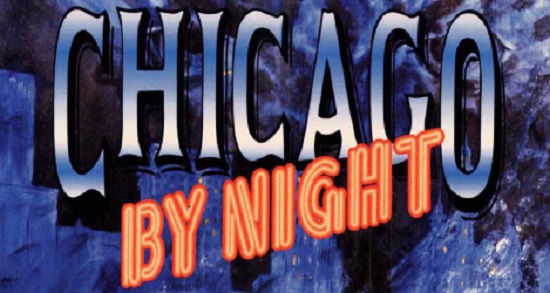 Chapter 4: Kindred (cont.) 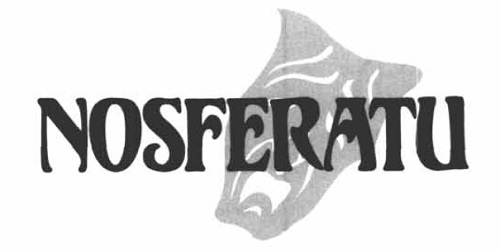 The Nosferatu clan structure in Chicago disintegrated under the pressure of the war; once well-organized and cohesive, the Nosferatu have dissolved completely into independent agents. The previous leader is still around and acts through his connections and allies, but he has no influence over the rest of his clan members. Not like the city isn’t crawling with Nosferatu anyway. 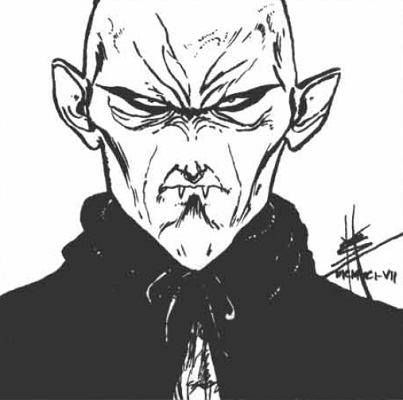 Nathaniel Bordruff spent his mortal life hunting vampires in New Orleans. After years of successfully picking off stragglers, Nathaniel let his pride get the better of him and got duped and turned by one of his targets. After unsuccessfully hunting vampires as a vampire for a little while (no public recognition, you see), he left Louisiana and migrated up to Chicago, where he ingratiated himself to Lodin and his followers; today he’s an established fixer in Chicago vampiric politics with a reputation for backing the right person. His secret? Nathaniel still hates vampires. He doesn’t like humans, he doesn’t give a poo poo about humanity; he only hates vampires and that’s the base of his personality. Everything he does is tilted towards killing off kindred, even as he functions as part of their society. 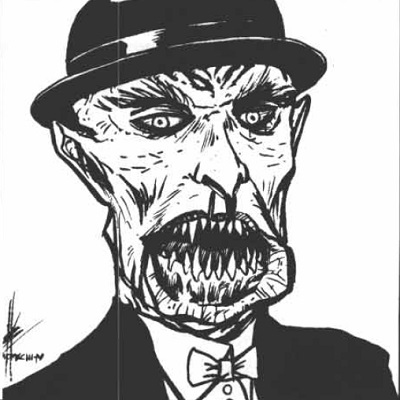 Cedric Calhoun was the black sheep of a prominent southern Illinois political dynasty, sent to a boarding school in Colorado to hide various physical deformities from his family’s constituents. After escaping and nearly dying at the hands of an old Malkavian, a Nosferatu diablerist took him in, trained him, and eventually Embraced him; the two formed a bond of mutual affection only broken when his sire bit it trying to take down an old Gangrel. Cedric went home, realized his brother’s career was based on using his legacy for pity points, killed him, realized he was a genuinely good person who believed what he said after going through his records, silently protected his nieces and nephews until they reached a happy and prosperous adulthood, and then turned himself into a wandering righter of wrongs. He underwent another crisis of conscience when he realized his efforts weren’t making a permanent impact, so when he heard about the fighting in Chicago, he picked up and moved in with an eye on weakening vampiric power to prevent them from running roughshod over the locals. As far as characters no, he’s a cheerful new politician and information broker, the sort of person so nice you can’t help but think they’re hiding something. Which he is, but that secret's that he's a good person. Come on, look at that handsome gentleman. That's the face of a friend. The other Nosferatu include Khalid (a former fighter in the Crusades who used to run the clan in Chicago and now tries to do the whole noble demon, balance-my-darker-urges-with-my-noble-soul thing) and Tammy Walenski (who was embraced with her brother after they killed their abusive parents, who’ve returned to haunt her after her brother died during the war). Pretty wicked portraits all around.  Chicago’s Toreadors have a well-deserved reputation as being posers. At least, according to the clan introduction; I’m not sure the book bears it out. However, many of city’s strongest vampires are Toreadors, enough that pound for pound they outmatch any other group. Especially because of one of their number…  Helena is Helen of Troy. Well, kind of, her past is a patchwork of misremembered Greek legends and vampire history that roughly adds up to that. She’s been fighting with Menele for centuries on-and-off with her equally ancient boyfriend Prias (not a vampire, she’d kept him alive by feeding him her blood). The book credits her with orchestrating the discovery of the New World when she detected him hiding there and with the destruction of the Aztecs, Mayans, and Incas chasing him, which  Kathy Glens was an aspiring female rocker in the 1970s who refused to compromise her art to satisfy societal expectations of women performers. Eventually a Toreador admirer approached her, Embraced her, and helped her set herself up at the head of the nascent punk movement; she was one of Baby Chorus’s founders (I’ll get into that band next chapter) and indisputably its most talented member. The werewolves killed off two of her best friends (including her sire) and mutilated her during an attack a couple months ago. Ever since, she’s been hiding from the public, trying (and failing) to manage her PTSD by obsessively recording music before forgetting about it. Worth noting: she has Celerity 5 that she only uses for The rest are various flavors of Helena’s followers, mostly powerful vampires she’s dominated.  With the Gangrel and Nosferatu shattered, the Tremere have taken over as the most influential clan in Chicago (barring the Ventrue, of course). Unfortunately for them, Tremere command sees Chicago as a dumping ground for incompetents mostly there to gather info without costing them much if they die off. 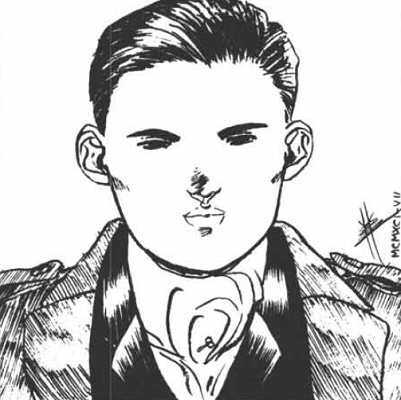 Nicolai Antonescu was one of the first Tremere, the young apprentice of one of the mages that turned themselves into vampires. Despite being hundreds of years old, he never really grew out of being 14 and between his mindset and appearance never won much respect from anybody. The other clan elders gave him Chicago as a reward for services rendered and he ended up playing a key role in Maxwell’s expulsion shortly after he arrived, gaining Lodin’s support and enough influence to set up his network. After years of politicking, he’s finally met his match in Helena, who’s been quietly playing him and bringing him under her influence. Also he has like a billion spells. 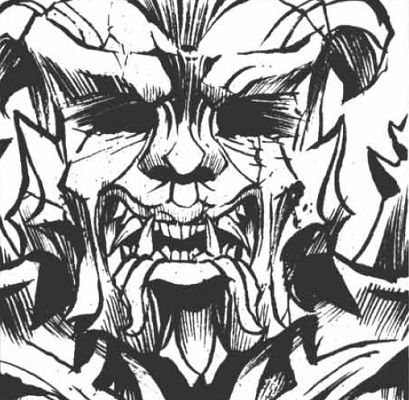 Ublo-Satha is a gargoyle, an experienced servant of the Tremere Inner Seven noted by one of its members for her unusual intelligence and competence; her overseer and patron back home used her as his secret agent for as long as she can remember (she doesn’t remember being a vampire). He dispatched her to Chicago to feed him information on the situation there and entered deep cover as a chantry guard. Unfortunately for her, way back when Menele planted a backdoor in her head that led him subtly puppeteer her and use her as an agent. Right now, he’s just making her continue her mission and keeping her in reserve. The other Tremere include a former lawyer and Nicolai’s primary lieutenant, and a former theosophist who’s a member of the city’s mage community; if they find out someone’s trying to kill her (if someone decides to try to kill her), they’ll rally to her side even after finding out she’s a vampire.  The Ventrue are the Ventrue. They all think they’re brilliant puppet masters and most of them are wrong. The vast majority of clan biographies are really boring and predictable: Lodin’s former lieutenant turned Sabbat, a corrupt businessman, a corrupt accountant, a corrupt gang leader, an incel hacker, and the sort of journalist who yells about suppressing free speech when his articles fall flat and liberal bias when anyone else’s succeed. Definitely the most despicable is the corrupt economist, who only feeds on abused women he’s dominated, including his eldest daughter 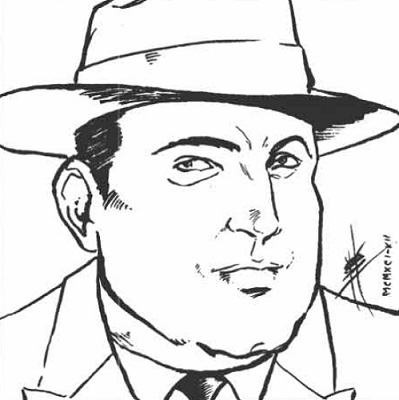 Yep, it’s Al Capone. His biography remains the same up until Lodin had him jailed for tax fraud and Embraced him, letting him loose as his agent. Ever since he’s been the de facto ruler of Chicago’s underworld (though the gangs have managed to slip his control). Right now he’s mostly focusing on fighting his rival, the corrupt politician above, but rumor has it he’s started to hunt for Golconda and taking a lighter tack towards the outside world. Either way, the book gives us role-playing information that amounts to “he’s adopted his Hollywood persona, make him act like that”. 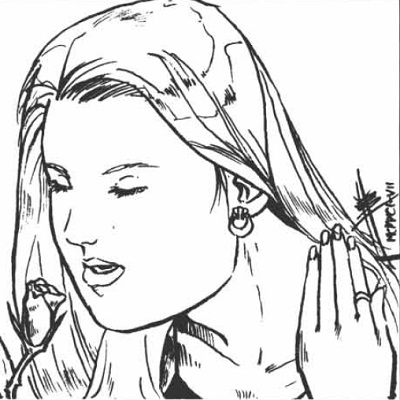 Lorraine Matthews was both Lodin’s girlfriend (and his descendent). A born space cadet raised in luxury, she got into hallucinogens in college, where she met Lodin; he engaged her in conversation at a party while on the hunt, found her absolutely fascinating (she’d just dropped acid), tripped as well after feeding on her, and ended up Embracing her that night. Lorraine ended up Lodin’s touchstone and romantic partner. Whenever he had a moment, he’d grab her somebody on LSD or Ecstasy or something, feed off her as she fed off them, then teach her Disciplines or just talk for a while before going back to work. She was on vacation when war broke out and came back to find Lodin suddenly dead; it broke her heart, and she’s probably the only person in the world who actually mourns him. To try and deal with her grief, she decided that Lodin planned to make Golconda more accessible to the city’s population (he did not) and dedicated herself to seeing his (fake) plan through. Despite being constantly high, low in skills, and 27, she has access to his old files, base stats about as high as they go on humans, and a dozen Disciplines at least at base level, plus some pull with her family and Lodin’s old contacts. Lorraine is one of the few characters in this book I actually like. The way the book combines her acid casualty demeanor with her statistical potential lets GMs twist her character in all sorts of ways; she can become anything from a hapless patsy to, with time and training, a Prince in her own right, all depending on what choices they and their players make. Very much someone who can evolve alongside the party. The rest of the endless waves of vampire clans don’t have any organized presence in Chicago, but that doesn’t mean they aren’t present. The rest of this chapter is dedicated to members of those other bloodlines, including the Sabbat.
|
|
|
|
Look at all these characters in a city where like two of them matter because they're older than dirt and going to level the city fighting each other.
|
|
|
|
The thing about Chicago is that you could literally delete Menele and Helena and nothing else would change, because aside from being the generic puppeteers of everybody, nobody knows who they are and they aren't involved in anything except their own old feud.
|
|
|
|
Rand Brittain posted:The thing about Chicago is that you could literally delete Menele and Helena and nothing else would change, because aside from being the generic puppeteers of everybody, nobody knows who they are and they aren't involved in anything except their own old feud. Heck, they don't even want anything but to resolve their old feud. And that old feud has a ton of backstory that the players might reasonably never interact with, because they're both cryptic old vampires who don't explain poo poo to anybody. So they're basically interchangeable as far as the PCs are concerned, with the only differentiation being what other NPCs are whose puppets. These guys are the worst. Also, Prias? What the hell is this Alucard bullshit?
|
|
|
|
Ratoslov posted:Heck, they don't even want anything but to resolve their old feud. And that old feud has a ton of backstory that the players might reasonably never interact with, because they're both cryptic old vampires who don't explain poo poo to anybody. So they're basically interchangeable as far as the PCs are concerned, with the only differentiation being what other NPCs are whose puppets. These guys are the worst. I think it’s supposed to be a layers-within-layers thing; you enter the city, realize there’s no prince, discover the primogen, and eventually find the methuselahs after digging through all the conspiracies. Cue climactic confrontation with one or both. Doesn’t make them actually useful to GMs, though, given how they trivialize things, and especially given how the book gives very little guidance on how to actually use them in play beyond their motivations and puppets.
|
|
|
|
There's a local guitarist vampire with celerity loving 5. That's a random local personality. No way are player characters doing anything but kissing the feet of these 3000 year old slap fighters.
|
|
|
wiegieman posted:There's a local guitarist vampire with celerity loving 5. That's a random local personality. No way are player characters doing anything but kissing the feet of these 3000 year old slap fighters.
|
|
|
|
|
Drakyn posted:It is doomsday, my dudes i appreciated this
|
|
|
|
same. I miss out on the wednesday frog because I always see it on thursday morning, but it is always doomsday this year, and lord kroak is watching out for us
|
|
|
|
Ratoslov posted:
I mean the acceleration is a joke, but supporting hybrid-cars in general at least gives some decent tummy feels. I've driven worse. (Also no way in hell the authors did this on purpose but that would be an excellent example of phonological metathesis so that would actually be a totally probable thing.)
|
|
|
|
Lodin would have been smarter to embrace Tony Accardo.
|
|
|
|
Adding Al Capone was a really lazy move, especially if the writers are having him just emulating his big screen image. Should have gone with a syphilis damaged turned Malkavian who no one can actually tell for sure is or isn't Al Capone.
|
|
|
|
thatbastardken posted:i appreciated this Same. Lord Kroak was always one of my favourite parts of Warhammer lore and I am so so happy to see him make a triumphant return. Just seeing this ancient frog mummy start exploding greater demons and casually deleting entire chaos groups is the best mental image. "Hahahah, my impossibly complex plan is nearly at fruition, truly nothing can..." -hovering corpse frog gets closer- "TRULY NOTHING CAN STOP"
|
|
|
|
Spellfire would have been a much better game if the cards had been replaced with The Deck of Encounters Set Two Part 62: The Deck of Trolls, Unicorns, and Lawyers 313: Raiding The PCs are asked to visit some farms and warn them about raiding orcs. The orcs have already been taken care of, though… by a band of raiding troglodytes. The card author assumes the PCs will seek out the orcs, and find the trogs feeding on their remains. The trogs will swarm to attack them, counting on their numbers to bring them victory. Boring. Not into it. Pass. 314: Troll Bridge Some trolls have set up a boulder on a hill across a bridge, which they will release when people are halfway across the bridge, then attack from both sides. Potential for 3d6 damage if you’re hit, or 2d6 if you jump off- pretty high bridge, I guess. Below the bridge is a stream, so if you jump off or are knocked off you’re not going to drown, but you’re in muck that stops you from using your Dex bonus to AC. Actually kind of a neat little set-piece combat. But have the trolls ever used this trap before? I might expect blood splatters on the side of the bridge and a trail of old blood over the path of the boulder. Or whatever. Keep, but I’m going to assume the PCs catch wind of the trap before it is released. 315: I’m So Confused The PCs are in some subterranean chamber, maybe even in a dwarf or gnomish city. Then… two umber hulks attack, first by causing a small cave-in above the PCs, then bursting into the chamber. The card heavily emphasizes how cramped the room is, and how narrow the tunnels leading into and out of it. It’s supposed to be “frustrating.” Forced combat, but the change in environment is nice. This gives an opportunity for the PCs to panic a bit. Keep. 316: Beauty Is This card does NOT feature a beholder. Someone deserves applause just for that. The PCs come across the trail of a large mixed group of humanoids (over 100), including mostly orcs but also gnolls and a giant. They’re off to hunt a couple unicorns, and the PCs will catch up with them in the middle of a raging battle. Carnage everywhere. Most of the humanoids dead. Unicorns are badasses, apparently. The female of the pair is taken down by a giant just as the PCs show up, though. If they save the unicorns, they’ll be grateful, of course. I could use a reason why these humanoids have apparently declared total friggin’ war on the unicorns, but OK. Keep. 317: Dewey Cheatam and Howe Mr. Howe, a lawyer gnome, approaches the PC in an inn. He’s got a loan contract apparently signed by one of the PCs. They supposedly borrowed 8,000 gp and need to pay back 11,000 by tonight. The fine print reads that if they’re “in arrears, two of his [sic] levels are forfeit for every day he is late.” Two of his levels? Yes. He will be visited that night by Miss Cheatam, a vampire. There are some holes here, like why the hell the PC’s (forged?) signature is on that contract, but this is so weird I can’t help but be charmed. Keep.
|
|
|
|
Dallbun posted:317: Dewey Cheatam and Howe I'm surprised the gnome wasn't D. Cheatam and the vampire Miss Howe. The names line up better that way. Or maybe it's just me that thinks Cheatam sounds more like a gnome surname.
|
|
|
|
I guess they figured opening up with someone named Cheatem would've been too obvious.
|
|
|
|
Dallbun posted:317: Dewey Cheatam and Howe I also love the random full-on fourth wall break. Not gonna call it blood or life force or whatever, just levels.
|
|
|
|
Age of Sigmar Lore Chat: Seraphon My Aesthetic Is Horns Everywhere  Saurus Warriors make up the vast majority of the saurus, and their entire existence is for battle and violence. They are unstoppably loyal to their slann, will die if that's what it takes to fulfill their mission, and know no mercy for Chaos or anything that aids it. Like all Seraphon, they are born from spawning pools, dragging themselves out of the shining waters as full adults awaiting orders. Generally, an entire unit of saurus is spawned simultaneously, and these spawn-kin have a near-telepathic bond that links them all, allowing them to operate in perfect harmony in battle no matter how enraged they become. They instinctively can sense the actions of their spawn-brethren, moving to defend as the warrior next to them attacks or going on the offensive to take advantage of feints. This means they need none of the training in discipline that other species require, and it is the real reason they are so terrifying. Yes, they are bestial warriors of primal strength and natural talent for violence, but all of that pales in comparison to their ability to perform complex military maneuvers on instinct alone, obeying simple growls as if they were full orders. Every part of a saurus' body is theoretically a weapon. Their claws are like daggers attached to their hands and feet, and their sheer muscle means that they can tackle and take down even a full-grown ogor easily. Their tails can whip with enough speed to break legs, and their jaws are easily capable of shattering human skulls in a single bite. They only become more dangerous when given weapons. Some favor celestite clubs or macuahuitls, mixing bludgeon and blade together with nasty spikes. Others use celestite spears to form a deadly wall against enemy charges. Even their shields are theoretically weapons, with bladed edges to cut foes when the saurus has nothing better at hand to use. It is unsurprising, then, that despite being purely creatures of war, they often have amazingly long lives. When not in battle, saurus duties are highly variable, though still related to war in some way. On the temple-fleets of the Starborne, the Saurus are often given no specific task most of the time, allowing them to roam and hunt in the world-chambers as they like. Many saurus don't take advantage of this - they often keep themselves in suspended animation in hibernation capsules until they are needed, and sometimes they are directed to do so by their leaders, so that they can always be at their best when the skink priests activate the revivification engines. Even the priests don't fully understand the mechanics behind the rituals they perform to awaken the sleeping saurus, but they know it involves machinery that warms the blood and calls them back to life from cold slumber so they can be sent to battle again. Coalesced saurus have no such luxury, as they must work to guard their temple-cities. They patrol the outer edges, and many saurus enjoy wall-guard duty, where they can stand perfectly motionless for hours on end. They also enjoy hunting for prey in the jungles of their homes or patrolling for enemies. They're hard to ambush in the first place when on patrol, but not impossible. The hard part is killing them all in the initial attack, because if even one survives, he will fight with unrelenting dedication, buying time for reinforcements to arrive. The Coalesced saurus tend to be even more savage and vicious than the Starborne of their kind, as their predatory nature is amplified by the magical energies that have given them true flesh. Other species have many legends about the feral, cold-blooded warrior-lizards. In Ghur's Caverns of Ravvagas, there are centuries-old cave paintings showing the saurus descending from the stars to strike down sorcerer-kings that once ruled the land. The Heartgash Grand Court of Flesh-Eaters is known to wear the hides of reptilian beasts and wield crudely made clubs and spears of bone, thinking themselves to be the primal figures their culture once met, long ago, before the Flesh-Eater Curse fell upon them. And yet, the species that likes the saurus best outside the Seraphon is, to their mild distaste, the orruks. Both Ironjaw and Bonesplitter orruks consider the saurus to be exceptionally fun opponents, if sadly humorless, and some more cunning orruks have taken to erecting defaced and broken totems of Chaos in an effort to trick the Seraphon into attacking them, having noticed a pattern to their raids. The Saurus Guard are a smaller group among the saurus, serving as specialized defenders who lock their shields together and protect the slann. Each dreams of being chosen to be an Eternity Warden, and even in times of peace, they remain rather twitchy and prone to violence if someone approaches the slann they guard incautiously - even other Seraphon. There's been several skinks that lost their lives to being unfortunately a little too stealthy in their approach to their master. Saurus Guard are chosen at spawning, and unlike other saurus, they are rarely spawned in groups. Rather, a slann's Guard are kept at a constant number, and as Guards fall in battle, new saurus are spawned to replace them in ones or twos. These special spawnings produce saurus who instinctively seek out the sacred weapons of the Guard and join their ranks, treating their fellows as spawn-kin despite their sometimes vast difference in age. Saurus Guards rarely have many casualties, though - their scales are thicker than those of other saurus, and they can survive blows that would kill normal Saurus Warriors instantly. One of the greatest legends of the Age of Chaos is about the Guard of the Starmaster Lumqu, who locked their shields in a dome over their slann and withstood the full force of the Brazen Gargant, a truly immense Khornate warlord. Besides the slann, Saurus Guard can also be found watching over important areas in Seraphon temple-ships or cities, or important strategic locations - realmstone caches, scrying chambers, vaults of Old Ones technology, spawning pools, that kind of thing. They are capable of surviving for decades without food or water, standing in perfect stillness until an intruder shows up and becomes their next meal. Saurus Knights ride at the front of the Seraphon armies, serving as cavalry shock troopers. They are masters of hit-and-run attacks and linebreaking charges, going into battle under banners of the coiling serpent. They are aggressive and violent - a reflection of their mounts, the Cold Ones. These creatures are immensely territorial and bad-tempered creatures, prone to reverting to their primal state if not kept in line. The skinks try to stay out of their way, as atavistic Cold Ones are prone to trying to eat them. A Cold One pack loose in a ship or city can cause all kinds of trouble until the Knights arrive to round them up. Knights are a saurus subspecies who are widely considered to be blessed by the Old One the skinks have named Itzi, Father of Beasts. Their dewclaws are specially adapted to let them direct their mounts in battle without needing to use their hands or any reins. The Saurus Knights possess an innate affinity for wild animals in general and Cold Ones specifically. In the presence of a Knight, a Cold One goes from a bad-tempered and dangerous animal to a focused and obedient warbeast that acts in perfect unison with its rider. Next time: Tiny Good Friends
|
|
|
Mors Rattus posted:And yet, the species that likes the saurus best outside the Seraphon is, to their mild distaste, the orruks. Both Ironjaw and Bonesplitter orruks consider the saurus to be exceptionally fun opponents, if sadly humorless, and some more cunning orruks have taken to erecting defaced and broken totems of Chaos in an effort to trick the Seraphon into attacking them, having noticed a pattern to their raids. Orcs building fake totems to Chaos to get to fight against saurus owns a lot.
|
|
|
|
|
Mors Rattus posted:They patrol the outer edges, and many saurus enjoy wall-guard duty, where they can stand perfectly motionless for hours on end. I'm imagining this like the tourists that try to aggravate the various royal guards around the place in Europe whose jobs are mostly to stand stock still, control their bladders and occasionally yell loudly and march about for a minute. Trying to either goad them into changing their expression or into giving them a fight. Propping up a dead chaos warrior on a stick from a ditch and puppeting him around. "OY! I'Z CAN'T WAIT TO GET UP TO SOME CHAOSY GUBBINS! SURE HOPE NO LIZARD BLOKE GETS T' STOPPIN' ME!" This has been going on for five days with the chaos warrior visibly more and more decayed every day and the Saurus warriors on duty are starting to develop nervous tics. PurpleXVI fucked around with this message at 03:34 on Sep 9, 2020 |
|
|
|
 Chapter 4: Kindred (cont.)  The Sabbat only arrived in force after the war, despite having orchestrated it. See, one of the city’s major Brujahs has a dark secret; though she never joined it, she played a key part in the formation of the Sabbat way back when and they’ve been blackmailing her into hiding them. Right now, all their vamps in the city are disposable rejects intended to eventually blow her cover just by being their idiot selves and weaken an already fragile city by blowing up yet another power structure, at which point they can sweep in and take over. Unfortunately, most of these Sabbat are uninteresting losers that get maybe two paragraphs of development as opposed to the normal page or so. Of course, because you can’t have a consistent tone in this book, the first two characters (a French Cavalier turned urban scout and a power-hungry Tzimisce lawyer) are specifically named as up-and-coming leadership candidates, so who knows. Have a steroidal Ventrue antitribu for the road: 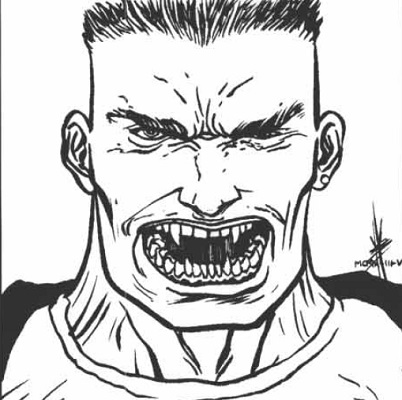 Just to round out the selection, we get a sampling of vampires from other clans, most of whom either only recently moved in or have been hiding under the radar for a very long time.  Rebekah has a long and convoluted personal history that goes back to her time in the Zealots as a mortal, but none of it really matters. Long story short, she hated her need to feed on people so much that she reached Golconda and joined the Inconnu. She’s the Monitor of Chicago, in charge feeding the the group information on the city: either she has an inkling of the whole Helena-Menele situation or she completely understands it, depending on whether you believe the fluff or the stats. Rebekah broke her noninterference policy in the 80s to look after Maldavis, who she’s adopted as a sort of protégé without her even realizing. Granted, Maldavis lost the fight, but Rebekah never stopped looking out for her, even silently Dominating werewolves that threatened her during the war. She’s even started guiding Maldavis to Golconda through her dreams, which she can do with the dozens of points she has in various disciplines, including several that give her special abilities. I think the book wants her to be a wild card that keeps the Methuselah situation from becoming too static. Also she lives in the Shedd 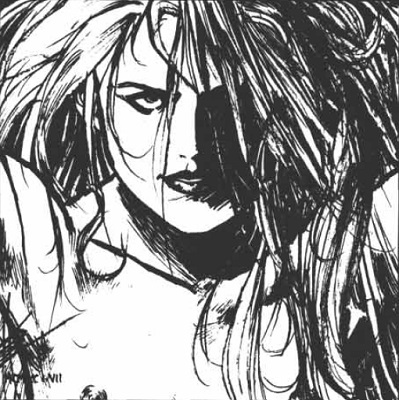 Gulfora is a succubus, and a very old one. As in, the book pins her earliest activities in 2300 BC. She moved to Chicago as the rail system developed to feed off the masses there. Not a long entry here, but it’s notable for two reasons:
The rest of the section, outside of one extremely dedicated euthanasia advocate, consists of various ethnic stereotypes  . None of them are as bad as I’ve hit elsewhere in the book, though; I’m practically a connoisseur at this point. In fact, I’d say that sentiment defines the chapter: it could have been worse. It has at least two serious lows and its highs are unpleasantly flaccid. At least Rebekah’s there to through a spanner in the works, right? . None of them are as bad as I’ve hit elsewhere in the book, though; I’m practically a connoisseur at this point. In fact, I’d say that sentiment defines the chapter: it could have been worse. It has at least two serious lows and its highs are unpleasantly flaccid. At least Rebekah’s there to through a spanner in the works, right? With that chapter dead in the ground, we move on to the last: coteries.
|
|
|
|

|
| # ? Apr 26, 2024 09:27 |
|
Mind War ! Warriors of the Green Planet !  The first thing after the cover is a full page of typewritten history. This is 1976. I’m still in Massachusetts. Desktop Publishing is a decade away. Cut and paste still meant an Xacto knife and actual paste. The fact that they got the chapter headers in with a larger typeface says a lot for the quality of the layout. In 2037 the Earth flipped on its axis. This isn’t an extinction event, but pretty much everything man-made falls down all at once. Civilization ends and people start digging out and putting everything back together. It turns out that Africa got lucky and had the least damage from the event. On top of that, there is a continent-wide Wakanda moment as they discover special diamond forms good for fusion power and directed-energy weapons. As a spinoff they have lots of free helium, so there you go: fusion powered airships with beam weapons in an age of warlords and rebuilding. That’s as good an excuse for airship warfare as any setting has ever had, I’m completely hip to this. 500-odd years after the cataclysm psychic powers have also emerged. There’s more history about the Mind Guild, but we’re on the first numbered page and we already have psychic wars and airships coming out of Africa to re-civilize the globe. It’s a goddamned shame this setting faceplanted as soon as it hit retail. But this is 1976, gaming is in its infancy. Social mores weren’t maybe in tune with “Africa re-civilize the world” back then, but a revival of this property today could hit six figures on Kickstarter. Not least because at least one of the three games they did was actually good. Mind War !  After the backstory and some art, we get to the actual game. This is a WEPLOT-WEGO game. Everybody plots their moves, attacks, and defenses. Then movement happens and there’s a phase to plot a reserve allocation to attack or defense. Para-psis come in three classes. They have a base strength from their class (which is public knowledge), plus a small random factor which is a secret. That total is fixed for the game and you can neither spend more points than you have, nor save points for next turn. The random factor is based on a secret chit draw, so there’s a record.  If you look at the game tables, a class 3 is worth three or 4 class 1 characters in raw power. You’ll also see that movement costs ramp up very quickly. Ignore the Attack Strength table for now. You plot movement, attacks, defenses, and reserves in a very structured fashion I will not go into. Any mistakes invalidate and cancel all of your attacks and defenses. That’s bad. You may examine your opponent’s plot at the end of the game if you think they’re sketch. Note later that some actions might not be revealed, this adds to the bluffing quality of the game. Movement. Let's start with the map,  Movement is point to point on the map, instantaneous, and secretly plotted. If two characters end up in the same circle, both characters have their plot cancelled for the turn, including attack and defense. On the first turn, all characters must move onto the board, paying 1 psi point for a 1-space move. There is a small ambiguity here. First, if Albeth moves from 3 to 12, but Bekel also moves to 12, fine, they bounce. What happens if Caron plotted a move to 3 ? It’s pretty obvious that Caron also gets bounced back to where they started, but it’s left unclear - possibly for reasons of space. Or they’d already laid out that page and didn’t have room for it. Attack. An attack has a range of 2 and does not diminish with range. An attack is plotted into a circle adjacent to where the character ends their move and then into any point adjacent to that one, along with a strength in psi points. If two or more attacks enter a circle from the same direction, their strengths are combined. You may plot more than one attack, and you may launch multiple attacks into a circle that split off and end in different, adjacent circles. Attacks are capped at 7 psi points each. One nice touch, if nobody is in range to even possibly attack another character after movement is revealed, then the turn ends without plotted attacks and defenses being revealed. Defense You can spend up to 7 psi points to put up a shield between your circle (where you ended movement) and an adjacent shield. Any attack points coming from that direction have to overcome your shield. You may have more than one shield up, covering different directions. Do not reveal defensive plots if no attack tests them. Reserves You may save 0,1, or 2 psi points from your initial plot each turn. After movement, you may add them to any existing attack or defense plot, observing the 7 point limit. Class 1 psis may not allocate reserves. Resolution Now we’re using the Attack Strength table ! It’s pretty simple, subtract the defensive shield’s strength from the power in the attack. If there’s any left, find that column and roll a d6. Results are in whole classs lost. If you lose a class, you draw a new random chit to add to your new - lower - base psi strength. So landing a 3 point attack on someone has a 50% chance of them losing at least one class, and a 16% chance of two. The game ends when only one player (or team) has characters on the board. Optional Rules There are two: The Black Maw of Baak. Spend all of your psi points creating a void in one circle. Anyone moving into or through a Maw is *poof* gone. The Move of Last Resort. Something else a class 1 can’t do. If you are taking an attack AND have 2 points of unused Reserve plotted, you can try and cancel the attack and move into an adjacent circle. Hope there aren’t any attacks plotted there. You roll a die for effect. One a 1 it doesn’t work and all attacks and defenses are as plotted, 2-5 it works, 6 it works but you lose 4 points of strength until the end of the game (or you lose a whole class). Scenarios There are 5 scenarios, and three of them are class 1, 2, or 3 1v1 duels. But they come with backstory, so that’s cool. Number 4 is a class 3 against 2 class 2s. The fifth scenario is 3 players each with a class 2 psi. Rolling your own matchups should be easy. There you have it, Mind War in all its 1976, typewritten glory !
|
|
|
























